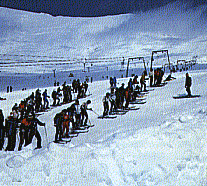|
The Lebanese
People at Home and Abroad:
Lebanon was given freedom in 1918 by the victory of the Allies
and achieved full independence in 1943. Always a nation of travelers
and traders, by the early 1970's there were some 2 million Lebanese
living in their homeland while an almost equal number had settled in
every continent of the world. After 1975 the war encouraged even
larger numbers to emigrate to western and Arab countries where they
have contributed their skills, notably in the fields of science,
medicine and commerce. At home or abroad the Lebanese are known for
their kindness and hospitality. These qualities, combined with
family oriented way of life, make visitors feel both welcome and at
ease.
A Country for All
Seasons:
Lebanon is one of the few winter sports centers
in the Middle East and certainly the most extensive. The season
begins in December and continues until April in a winter landscape
unique
in the world. The larger resorts have hotels, chalets
and other facilities, including good ski lifts.
There are six winter resorts: The Cedars (2,300 meters), Faraya/Ouyoun
es-Siman (1,890 meters), Laqlouq
(1,740 meters), Faqra (1,750 meters), Qanat Bakiche (1,990 meters)
and Zaarour (1.990 meters).
 In
Lebanon you can swim in the sea In
Lebanon you can swim in the sea
in winter as well as spring and an hour later ski at 1,900 meters.
It almost never rains between June and October so in summer and
autumn it is easy to go from sea to mountain, where another world
awaits. Lebanon's mountain villages and towns are worth a visit any
time of the year. While some were damaged by war most are thriving
towns that offer not only entertainment but a glimpse of the
traditional life style not often seen in large cities.
In the Shouf
mountains there is Deir El Qamar with its white houses
and red tile roofs built on steep slopes. This was the residence of
the governors of Lebanon in the 16th-18th centuries. Many historic
buildings here have been restored, such as the Fakhreddin
Mosque and the Baz and Al-Kharge palaces. Most recently the central
square of this historic town was cleaned and restored.
Bsharré
in the north, the picturesque gateway to the Cedars of Lebanon, is
the birthplace of the famous Lebanese poet Gibran Khalil Gibran.
Here one may visit the Gibran Museum and the many ancient churches
and monasteries in the vicinity.
Zahlé,
the main city of the Beqaa, is popular for its arak, wine and
delicious food.
It's not surprising then that one of the main attractions here is
the oasis of vine-covered restaurants situated beside the cool
Bardouni rive. A picturesque town known for its comfortable climate,
Zahle is often referred to as the "Bride of the Beqaa".
The coastline between Tripoli and Sidon is punctuated
by all kinds of leisure facilities from well-equipped swim resorts
and family-run fish restaurants to luxurious condominiums. Between
Beirut and Byblos is the town of Jounieh which has a lovely
bay with craggy mountains rising just behind. Jounieh enjoys
one of the most beautiful natural settings on the coast, although
since 1975 high-rise buildings and resort complexes have somewhat
dwarfed the old town. Jounieh has long been known for the landmark
statue of the Virgin of Harissa high above the bay, reached
by road or by spectacular, near-vertical cable car ride. |





